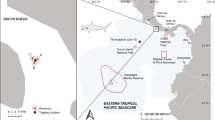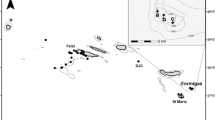Abstract
We examined the extent of movements of juvenile Florida pompano, Trachinotus carolinus, and gulf kingfish, Menticirrhus littoralis, along an open ocean beach. Fishes were collected by seine at three sites along Masonboro Island and Carolina Beach, NC between 7 June and 7 July 1995. All specimens 40 mm standard length (SL) were tagged with coded wire tags and released at the capture sites. Between 7 July and 9 August and on 15–16 September Masonboro Island and northern Carolina Beach were surveyed for tagged fish. A controlled tag mortality/retention study was conducted for both species. Overall, 1569 Florida pompano (40–135 mm SL) were tagged. Sixty-one (3.9%) of these were recaptured, and only eight moved away from the original tagging sites. The largest movements by two Florida pompano were 2.1 and 10.5 km. Many fish remained at their original tagging sites for 21–27 days. Of 488 gulf kingfish (36–158 mm SL) tagged, 16 (3.3%) were recaptured. Gulf kingfish also exhibited little movement away from tagging sites during the study, with individuals remaining at original tagging sites up to 21 days. Stock size estimates for Florida pompano ranged from 3354 to 4670 among the tagging sites, with densities ranging from 1.9 to 2.6 fish m−2. The remarkable site fidelity exhibited by these two species suggests that resources were not limiting or that predation pressure was not high enough to cause large scale movements during the study. This implies that local disturbances could impact behavior or survival of juvenile fishes in the surf zone.
Similar content being viewed by others
References cited
Anderson, W.D., Jr., J.K. Dias, R.K. Dias, D.M. Cupka & N.A. Chamberlain. 1977. The macrofauna of the surf zone off Folly Beach, South Carolina. NOAA Tech. Report. NMFS-SSRF-704. 23 pp.
Bearden, C.M. 1963. A contribution to the biology of the king whitings, genus Menticirrhus, of South Carolina. Cont. Bears Bluff Lab. 38: 1–27.
Bellinger, J.W. & J.W. Avault, Jr. 1970. Seasonal occurrence, growth, and length–weight relationship of juvenile pompano, Trachinotus carolinus, in Louisiana. Trans. Amer. Fish. Soc. 100: 353–358.
Bennett, B.A. 1989. The fish community of a moderately exposed beach on the southwestern Cape Coast of South Africa and an assessment of this habitat as a nursery for juvenile fish. Est. Coast. Shelf Sci. 28: 293–305.
Burke, J.S., D.S. Peters & P.J. Hanson. 1993. Morphological indices and otolith microstructure of Atlantic croaker, Micropogonias undulatus, as indicators of habitat quality along an estuarine pollution gradient. Env. Biol. Fish. 36: 25–33.
Cain, R.L. & J.M. Dean. 1976. Annual occurrence and diversity of fish in a South Carolina creek. Mar. Biol. 36: 369–379.
Dahlberg, M.D. 1972. An ecological study of Georgia coastal fishes. U.S. Fish. Bull. 70: 323–353.
DeLancey, L.B. 1984. Anecological study of the surf zone at Folly Beach, South Carolina. M.S. Thesis, College of Charleston, Charleston. 131 pp.
DeLancey, L.B. 1989. Trophic relationship in the surf zone during the summer at Folly Beach, South Carolina. J. Coast. Res. 5: 477–488.
Du Preez, H.H., A. McLachlan, J.F.K. Marais & A.C. Cockcroft. 1990. Bioenergetics of fishes in a high-energy surf-zone. Mar. Biol. 106: 1–12.
Fields, H.M. 1962. Pompanos (Trachinotus spp.) of South Atlantic coast of the United States. U.S. Fish. Bull. 62: 189–222.
Finucane, J.H. 1969. Ecology of the pompano (Trachinotus carolinus) and the permit (T. falcatus) in Florida. Trans. Amer. Fish. Soc. 3: 478–486.
Fletcher, D.H., F. Haw & P.K. Bergman. 1987. Retention of coded wire tags implanted into cheek musculature of largemouth bass. N. Amer. J. Fish. Manage. 7: 436–439.
Gilbert, C. 1986. Species profiles: life histories and environmental requirements of coastal fishes and invertebrates (South Florida) – Florida pompano. U.S. Fish Wildl. Serv. Biol. Rep. 82(11.42), TR EL-82-4. 14 pp.
Kendall, W.L. 1999. Robustness of closed capture–recapture methods to violations of the closure assumption. Ecology 80: 2517–2525.
Koenig, C.C. & F.C. Coleman. 1998. Absolute abundance and survival of juvenile gags in sea grass beds of the southeastern Gulf of Mexico. Trans. Amer. Fish. Soc. 127: 44–55.
Krebs, C.J. 1999. Ecological methodology, 2nd ed. Benjamin/Cummings, Menlo Park. 620 pp.
Lasiak, T.A. 1984. Structural aspects of the surf-zone fish assemblage at King's Beach, Algoa Bay, South Africa: long-term fluctuations. Est. Coast. Shelf Sci. 18: 459–483.
Layman, C.A. 2000. Fish assemblage structure of the shallow ocean surf-zone on the eastern shore of Virginia barrier islands. Est. Coast. Shelf Sci. 51: 201–213.
Miller, G.L. & S.C. Jorgenson. 1969. Seasonal abundance and length frequency distribution of some marine fishes in coastal Georgia. U.S. Fish Wildlf. Serv. Rept. No. 35. 102 pp.
Modde, T. 1980. Growth and residency of juvenile fishes within a surf zone habitat in the Gulf of Mexico. Gulf Res. Rep. 6: 377–385.
Modde, T. & S.T. Ross. 1981. Seasonality of fishes occupying a surf zone habitat in the Northern Gulf of Mexico. U.S. Fish. Bull. 78: 911–922.
Moyle, P.B. & J.J. Cech, Jr. 1988. Fishes. An introduction to ichthyology, 2nd ed. Prentice Hall, Englewood Cliffs. 559 pp.
National Research Council. 1995. Beach nourishment and protection. National Academy Press, Washington. 334 pp.
Otis, D.L., K.P. Burnham, G.C. White & D.R. Anderson. 1978. Statistical inference from capture data on closed animal populations. Wildl. Mono. 62: 1–135.
Peters, D.J. & W.G. Nelson. 1987. The seasonality and spatial patterns of juvenile surf zone fishes of the Florida east coast. Fla. Sci. 50: 85–99.
Peterson, M.S. & J.P. Key. 1992. Evaluation of hand-tagging juvenile walleyes with binary-coded wire microtags. N. Amer. J. Fish. Manage. 12: 814–818.
Ross, S.T., R.H. McMichael, Jr. & D.L. Ruple. 1987. Seasonal and diel variation in the standing crop of fishes and macroinvertebrates from a Gulf of Mexico surf zone. Est. Coast. Shelf Sci. 25: 391–412.
Ross, S.W. & S.P. Epperly. 1985. Utilization of shallow estuarine nursery areas by fishes in Pamlico Sound and adjacent tributaries, North Carolina. pp. 207–232. In: A. Yanez-Arancibia (ed.) Fish Community Ecology in Estuaries and Coastal Lagoons: Towards an Ecosystem Integration, UNAM Press, Mexico City. 654 pp.
Stokesbury, K.D.E. & S.W. Ross. 1997. Spatial distribution and an absolute density estimate of juvenile spot Leiostomus Xanthurus in the tidal fringe bordering a North Carolina Salt marsh. Mar. Ecol. Prog. Ser. 149: 289–294.
Sweeney, J., L. Deegan & R. Garritt. 1998. Population size and site fidelity of Fundulus heteroclitus in a macrotidal saltmarsh creek. Biol. Bull. 195: 238–239.
Szedlmayer, S.T. & J.C. Howe. 1995. An evaluation of six marking methods for age-0 red drum, Sciaenops ocellatus. U.S. Fish. Bull. 93: 191–195.
Tagatz, M.E. 1968. Fishes of the St. Johns River, Florida. Quat. J. Fl. Acad. Aci. 30: 25–50.
Tagatz, M.E. & D.L. Dudley. 1961. Seasonal occurrence of marine fishes in four shore habitats near Beaufort, N.C., 1957–60. U.S. Fish Wildl. Serv. SSRF 390. 19 pp.
Turner, W.R. & G.N. Johnson. 1973. Distribution and relative abundance of fishes in Newport River, North Carolina. NOAA Tech. Rept. NMFS-SSRF-666. 23 pp.
Varnell, L.M. & K.J. Havens. 1995. A comparison of dimensionadjusted catch data methods for assessment of fish and crab abundance in intertidal salt marsh. Estuaries 18: 319–325.
Varnell, L.M., K.J. Havens & C. Hershner. 1995. Daily variability in abundance and population characteristics of tidal salt-marsh fauna. Estuaries 18: 326–334.
Weinstein, M.P. 1979. Shallow marsh habitats as primary nurseries for fishes and shellfish, Cape Fear River, North Carolina. U.S. Fish. Bull. 77: 339–357.
Weinstein, M.P. 1983. Population dynamics of an estuarine dependent fish, the spot (Leiostomus xanthurus), along a tidal creekseagrass meadow coenocline. Can. J. Fish. Aquat. Sci. 40: 1633–1638.
Weinstein, M.P., L. Scott, S.P. O'Neil, R.C. Siegfried II & S.T. Szedlmayer. 1984. Population dynamics of spot, Leiostomus xanthurus, in polyhaline tidal creeks of the York River estuary, Virginia. Estuaries 7(4A): 444–450.
Author information
Authors and Affiliations
Rights and permissions
About this article
Cite this article
Ross, S.W., Lancaster, J.E. Movements and Site Fidelity of two Juvenile Fish Species Using Surf Zone Nursery Habitats Along The Southeastern North Carolina Coast. Environmental Biology of Fishes 63, 161–172 (2002). https://doi.org/10.1023/A:1014287917297
Issue Date:
DOI: https://doi.org/10.1023/A:1014287917297




